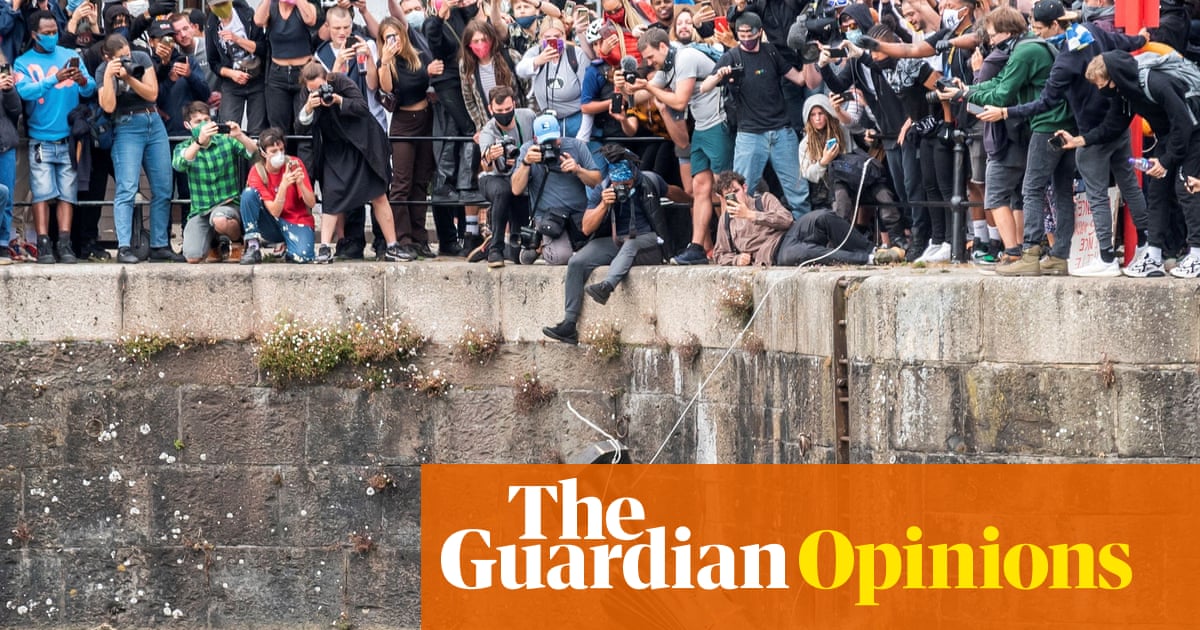The toppling of the statue of the British enslaver Edward Colston, five years ago today, felt like a historic moment. Bringing down this one statue and symbolically hurling it into Bristol harbour, protesters – predominantly white – drew international attention to the barbarity of African enslavement, its generated wealth that turbocharged the UK’s global power and the legacy of slavery, whose long historical tail had led to the murder of George Floyd less than two weeks before.
Five years on, however, it seems fanciful that out of those protests a global reset on race could occur. Back then, structural race inequities were also laid bare by the Covid-19 virus. We watched our TV screens with dread as the kaleidoscope of Black and Asian doctors, nurses and other health workers were dying disproportionately. Those same minoritised communities were also more likely to be in precarious jobs, forced to travel to work as cleaners, care workers and security guards, and were thereby more exposed to the deadly disease.
These two seismic occurrences sparked a discussion the likes of which we had never seen in the UK. Corporations held multiple staff meetings over what their response to the Black Lives Matter protests should be. I, along with other race equality activists, was often invited.
The discussions would usually begin with the chief executive or a director leading the conversation, proclaiming their commitment to race equality with the usual caveat: “But we must do better.” Then would come the uncomfortable truth, from their own Black staff, who for the first time felt emboldened to speak truth to power.
“I’ve been in your company for 20 years. I’ve lost count of how many white women I’ve brought in, trained up, only for them to be promoted and often become my line manager.”
“Normally we don’t dare speak out. Managers quickly spread the word that Black people are trouble and are always complaining.”
I witnessed one woman tell her boss: “I don’t care if you sack me. I’ve had enough. This charade, you being down with Black Lives Matter, is a bit like you showing up for 10 minutes to our Black History Month in-house event. It changes nothing.”
These were difficult and chastening conversations, but with the prolonged Black Lives Matter protests they did bring about action that we hoped might create generational change. For example, company boards began to look at their desperate lack of Black members. Institutions appointed some Black men and women to top roles. And perhaps one of the most noticeable changes was the way that advertisers, along with TV and film producers, placed Black characters in “everyday” roles, away from the usual villainous or holier-than-thou stereotypes. It could be argued that this cultural normalisation of Black and Asian faces on our TV screens may yet play a significant part in bringing communities closer together.
Educationally too, there was the beginning of what we thought would be institutional shifts. My own university, Cambridge, under the stewardship of the vice-chancellor Stephen Toope, had already begun itsfirst serious investigationinto its own slavery roots in 2019. After the toppling of Colston, many other universities, such as University College London, Newcastle, Nottingham and Nottingham Trent, opened up their archives. Others looked to broaden their curriculums, bringing in developing-world perspectives.
Yet despite so much optimism, the national momentum began to slow down, came to a halt and, in many quarters, is now in reverse. The most significant blocker to change came from Boris Johnson’s government, which in the face of the Black Lives Matter protests was forced to set up a race inquiry. Led by Tony Sewell, this report into systemic racism in the UK is widely seen as one of the mostflawed race reports ever written. Despite all the evidence, Sewell questioned the level of systemic racism in the UK and also claimed there was a positivestory to tell about the enslavement of Africans“not only being about profit and suffering but how culturally African people transformed themselves”. Sewell was given a peerage by Johnson in 2022.
Other factors that stalled the momentum included the rightwing attack on England football playerstaking the kneein support of Black Lives Matter. Then came theattacks on critical race theory, which examines the structural and systemic aspects to racial inequality. Fast forward to 2024 and the climate had gone from tackling race inequality to race hatred riots that sought to firebomb Muslims and refugees. The unprecedented scenes, whipped up by lies around the Southport killer but fuelled by years of Islamophobic and anti-migrant newspaper headlines, harked back to the Ku Klux Klan lynch mobs. And this year we have a US president who demands that businesses and all public institutions abandon their diversity, equity and inclusion (DEI) programmes. Many of those institutions, in the UK and the US, which had been seen as allies for the Black Lives Matter movement, didn’t take much persuasion to fall into line and abandon their commitments.
Five years on from that momentous day in Bristol, many of the hopes of generational and systemic change have evaporated. However, we can be somewhat hopeful that, while on the surface many companies have capitulated, some are covertly continuing with their DEI trajectory. Others, such as the Co-op, where I am a director, wear their DEI credentials as a badge of honour.
I think the greatest hope will come from the tens of thousands of people, Black and white, young and old, who demanded change during the longest race equality protest ever seen. They have neither gone away nor lost their ideals. The challenge, then, for this government and others, is to reconnect and empower them to demand that historical change they still want to see.
Simon Woolley is co-founder of Operation Black Vote and head of Homerton College, Cambridge
